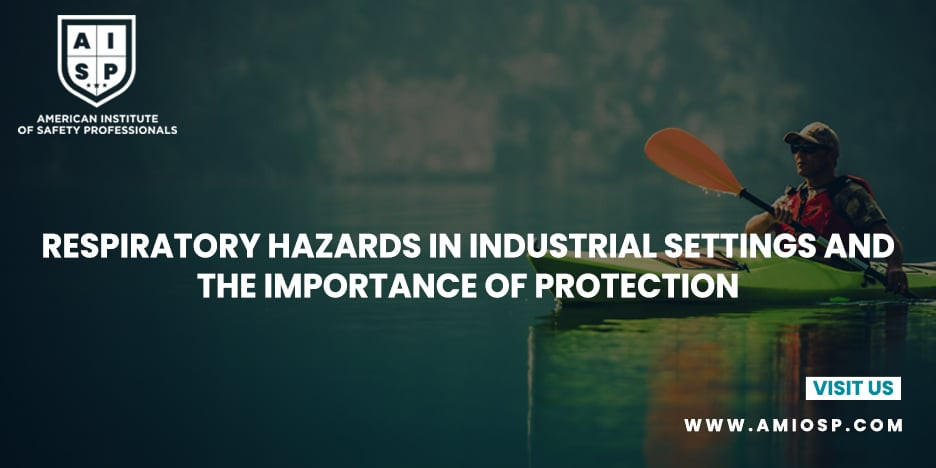Industrial settings often involve various respiratory
hazards that can pose serious risks to workers' health. Exposure to airborne
contaminants, such as dust, fumes, gases, and vapors, can lead to respiratory
illnesses, lung damage, and long-term health problems. In this blog, we will
discuss common respiratory hazards in industrial settings and emphasize the
importance of respiratory protection.
Identifying Respiratory Hazards in Industrial Settings
Industrial environments can present several respiratory
hazards, including:
- Particulate
Matter: Dust, fibers, and other solid particles can become airborne
during processes like grinding, cutting, and sanding. Inhalation of these
particles can lead to respiratory irritation, lung diseases, and even
cancer.
- Chemical
Fumes and Vapors: Many industries use chemicals that release hazardous
fumes and vapors, such as solvents, paints, and cleaning agents.
Inhalation of these chemicals can cause acute respiratory irritation,
chemical pneumonitis, or long-term damage to the lungs, liver, or other
organs.
- Toxic
Gases: Industries like manufacturing, mining, and petrochemicals may
generate toxic gases, including carbon monoxide, hydrogen sulfide,
ammonia, and chlorine. Inhalation of these gases can be life-threatening,
leading to asphyxiation, chemical burns, or systemic toxicity.
The Importance of Respiratory Protection
Implementing proper respiratory protection measures in
industrial settings is essential for the following reasons:
- Worker
Health and Safety: Protecting the respiratory health of workers is
paramount. Respiratory hazards can cause immediate health effects or have
long-term consequences, impacting both the worker's well-being and their
ability to perform their job effectively. Providing appropriate
respiratory protection ensures a safer and healthier work environment.
- Compliance
with Regulations: Regulatory bodies, such as the Occupational Safety
and Health Administration (OSHA), set standards and regulations to protect
workers from respiratory hazards. Compliance with these regulations is not
only a legal requirement but also demonstrates a commitment to worker
safety and helps prevent potential fines or penalties.
- Reduced
Absenteeism and Increased Productivity: By preventing respiratory
illnesses and maintaining the overall health of workers, respiratory
protection measures can contribute to reduced absenteeism and increased
productivity. Healthy employees are more likely to perform at their best,
resulting in a more efficient and successful industrial operation.
- Risk
Mitigation: Respiratory protection acts as a crucial risk mitigation
strategy. It minimizes the potential for occupational diseases and ensures
that workers are adequately protected from harmful airborne contaminants.
This, in turn, reduces liability and potential legal issues for the
employer.
Selecting Appropriate Respiratory Protection Equipment
Choosing the right respiratory protection equipment is vital
to ensure effective protection against specific hazards. Consider the following
factors when selecting respiratory protection:
- Type
of Hazard: Identify the specific respiratory hazards present in your
industrial setting. Different hazards may require different types of
respiratory protection, such as particulate respirators, gas masks, or
self-contained breathing apparatus (SCBA).
- Fit
and Seal: Proper fit and a secure seal are crucial for respiratory
protection. Ensure that the selected equipment fits well on the wearer's
face to prevent contaminants from entering. Fit testing should be
conducted to verify the effectiveness of the seal.
- Filtering
Efficiency: Select respiratory protection equipment with appropriate
filtering capabilities. Ensure that filters or cartridges are designed to
capture the specific hazards present in your industrial environment.
Training and Education
Proper training and education are essential components of
respiratory protection programs in industrial settings. Workers should receive
training on the following:
- Respiratory
Hazards: Educate workers about the specific respiratory hazards in
their work environment, including the health risks associated with
exposure.
- Proper
Use and Maintenance: Train workers on how to correctly wear, adjust,
and maintain their respiratory protection equipment. Emphasize the
importance of regular inspections, filter replacements, and cleaning
procedures.
- Emergency
Procedures: Provide clear guidelines on what to do in case of
emergencies, such as equipment malfunction or sudden exposure to
respiratory hazards. Workers should be familiar with evacuation routes and
procedures for using backup respiratory protection, if necessary.
Conclusion
Respiratory hazards in industrial settings pose significant
risks to workers' health and safety. By identifying these hazards, implementing
appropriate respiratory protection measures, and providing comprehensive
training, industrial companies can prioritize worker well-being and compliance
with regulations. Remember, respiratory protection is not just a requirement;
it is an investment in the health and future productivity of your workforce.












0 comments
No Comments